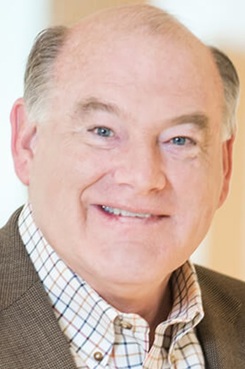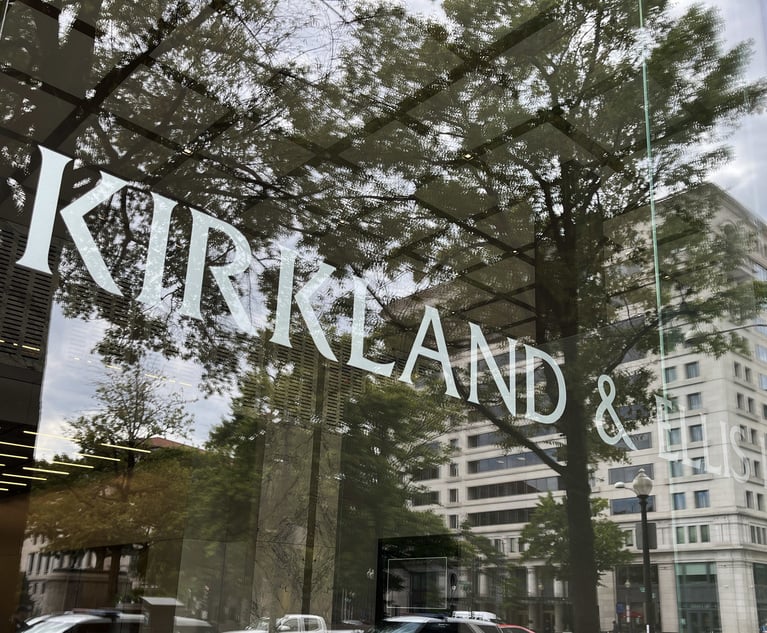Following Departures, Holland & Hart Looks to the Future
The firm has seen 72 lawyers leave so far this year. Its managing partner said the firm is positioning itself for the future.
November 02, 2018 at 02:56 PM
8 minute read
 The Colorado Rockies
The Colorado Rockies
This week, about 70 associates and of counsel from Holland & Hart converged on Park City, Utah, as part of an annual team-building event called the Holland & Hart Academy.
The event has rotated between Holland & Hart's Mountain West offices and this year, as part of a tradition related to the host city, will include a spotlight on the history of the Am Law Second Hundred firm's outpost in nearby Salt Lake City. The theme this year focuses on how young lawyers can build practices in response to a changing legal marketplace.
It is a timely topic, and the associates in attendance are likely to have questions about the direction of the Salt Lake office and the firm as it winds down a year of unusual lateral activity.
Through October, Holland & Hart has seen 72 lawyers leave its ranks, including 23 partners, 31 associates and 18 of counsel, according to ALM Intelligence. The departures have been most pronounced in Salt Lake City, where the firm's second-largest office has seen 23 lawyers leave—10 partners, 10 associates and three of counsel. The office now has 82 lawyers.
Thomas O'Donnell, Holland & Hart's managing partner, said in an interview this week that the departures his firm experienced this year were more than normal, but they were largely a result of a more active lateral market for partners, as well as retirements. Of the partners that departed, O'Donnell said 14 have gone on to other “platforms.” Holland & Hart has also added nine partners through lateral hires this year.
“We are in a profession that has not historically been known for our ability to adapt and change,” O'Donnell said. “And we are in a marketplace that is evolving and changing rapidly, and I think we pride ourselves for being in the category of law firms that are working hard on changing and adapting.”
The market for lateral partners is busier than ever. Through the middle of October, lateral partner moves among Am Law 100 firms were on pace to top 2,000 for the first time since ALM Intelligence began tracking such data in 2011. The previous high—1,851—was set in 2015.
Holland & Hart's departures in 2018 fit that general trend. Through October of last year, the firm had seen 55 lawyers leave, according to ALM Intelligence. Still, Holland & Hart's head count and gross revenue has flat-lined during the past three years. The firm's gross revenue in fiscal 2015 was $249.5 million. It reached $251 million in 2016 before dipping to $249 million in 2017. Head count last year fell to 433, down from 460 the year prior, according to data collected by The American Lawyer and sibling publication The National Law Journal.
As lateral activity picks up, firms with relatively low profits per equity partner (PPP) are at a disadvantage compared to deeper-pocketed peers. Holland & Hart's PPP of $445,000 last year ranked No. 191 in the Am Law 200.
This year, two notable groups departed Holland & Hart's Salt Lake office for Dorsey & Whitney, the latter of which named a new leader last month. The first, a team of 10 intellectual property partners, departed in February and included brothers Grant and Brett Foster, Mark Miller and Bryan Pratt. In September, a seven-lawyer corporate transactions team, including partners Matthew Wells, Aaron Murdock, James Kelly, Craig Frame and Jeffrey Bowman, made the jump. Wells is one of three Band 1 M&A partners in Utah ranked by Chambers and Partners.
Polsinelli, a firm whose namesake announced his retirement this week, also picked up three former Holland & Hart partners in Colorado earlier this year in Scott Berdan, Chuck Cotter and Elizabeth Harding. In Las Vegas, litigator and former local managing partner Patrick Reilly joined Brownstein Hyatt Farber Schreck in late September.
Like many firms, Holland & Hart is dealing with a transition from an aging partnership as baby boomers such as O'Donnell near retirement age. The firm has 52 lawyers who graduated law school in 1980 or earlier, putting them near the age of 60. Assuming its partners graduated law school at the age of 28, the average age of Holland & Hart's partners would be a little over 53, which is within the usual Am Law 100 range.
Generational transitions can be difficult for any firm, but the issue can be complicated at firms that have not relied on a high leverage model. Holland & Hart has traditionally been one of the lower-leveraged Am Law firms, typically near a 1:1 partner-to-associate ratio, O'Donnell said.
According to ALM Intelligence, Holland & Hart has roughly 210 partners, 120 associates and 90 of counsel, which is virtually a 1:1 ratio of partners to associates and of counsel.
“They have so many good, quality people that are 10-, 12-, 14-year lawyers but aren't partners,” said one former Holland & Hart partner who requested anonymity in discussing firm affairs. “They're leaving to go be partners.”
In an effort to give younger lawyers a clearer path to partnership, Holland & Hart, which has been a single-tier partnership, amended its partnership agreement this year to allow for nonequity partners. On Jan. 1, Holland & Hart will name five nonequity partners and four equity partners, O'Donnell said.
 Thomas O'Donnell
Thomas O'Donnell“We are always looking for ways to increase that leverage,” O'Donnell said. “One of the effects of people retiring is it allows us to add additional young lawyers in the associate and counsel ranks that help with that leverage. But we do it in a thoughtful way that isn't formulaic, but rather is reflective of the stage of people's careers and professional development.”
Holland & Hart has also made changes to aspects of its business that go beyond its people.
Last year, the firm sold two Colorado ski condos that it had owned dating back to the 1970s, bringing in about $1.8 million. An Aspen condo in the Chateau Eau Claire complex was sold in June 2017 for $1.465 million, while another condo in Steamboat Springs at the Trappeur's Crossing Resort was sold two months later for $337,500, according to Colorado real estate records.
O'Donnell said the condos had been used as a perk for the firm's lawyers, who could sign up as part of a rotation to use the properties. But as Holland & Hart's head count and geographic footprint grew, O'Donnell said it became difficult to ensure a fair amount of ski chalet access for the firm's lawyers. Through online survey tool SurveyMonkey, the firm's partners voted to sell the condos, O'Donnell said.
“In the early years, you'd be able to use them several times a year,” O'Donnell said. “Over time, you couldn't use them once but every couple of years. And the folks that were outside the Colorado Front Range area weren't really able to use them. It became increasingly unfair.”
O'Donnell said Holland & Hart believed the money spent keeping up the condos could be used better in other ways, including team-building exercises such as the one this week in the ski-friendly locale of Park City, as well as investing in technology.
In December 2017, Holland & Hart launched an innovation office with the hire of Duc Chu as technology innovation officer. O'Donnell said the Chu-led group has grown to five programmers and two data engineers. The group has also made applications aimed at document generation; tracking lawyer time; and automating aspects of the firm's patent, trademark and immigration practices.
“It's not a modest financial investment, but when you think about how you want to spend your money going forward, that's the name of the game,” O'Donnell said. “That's the future. And we're lucky to be well-positioned to play in that space and will continue to do so.”
Still, Holland & Hart is dealing with some angst from former partners who claim the return of their capital in the firm has been delayed. Holland & Hart, said two sources familiar with the firm's operations, is allowed up to 14 months to return capital, depending on when during the year a partner leaves. Some partners who have yet to receive their capital said they did not expect Holland & Hart to take as long as it has to return their capital.
While he declined to speak specifically about the firm's policies, O'Donnell said Holland & Hart has applied its partnership agreement evenly across all partners.
“We treat similarly situated people similarly,” he said. “That's what our partnership agreement provides. And when someone receives a return of capital has flatly nothing to do with the number of folks who left the partnership.”
This content has been archived. It is available through our partners, LexisNexis® and Bloomberg Law.
To view this content, please continue to their sites.
Not a Lexis Subscriber?
Subscribe Now
Not a Bloomberg Law Subscriber?
Subscribe Now
NOT FOR REPRINT
© 2025 ALM Global, LLC, All Rights Reserved. Request academic re-use from www.copyright.com. All other uses, submit a request to [email protected]. For more information visit Asset & Logo Licensing.
You Might Like
View All
Kirkland Is Entering a New Market. Will Its Rates Get a Warm Welcome?
5 minute read

Why Associates in This Growing Legal Market Are Leaving Their Firms

Trending Stories
- 1Decision of the Day: Judge Dismisses Defamation Suit by New York Philharmonic Oboist Accused of Sexual Misconduct
- 2California Court Denies Apple's Motion to Strike Allegations in Gender Bias Class Action
- 3US DOJ Threatens to Prosecute Local Officials Who Don't Aid Immigration Enforcement
- 4Kirkland Is Entering a New Market. Will Its Rates Get a Warm Welcome?
- 5African Law Firm Investigated Over ‘AI-Generated’ Case References
Who Got The Work
J. Brugh Lower of Gibbons has entered an appearance for industrial equipment supplier Devco Corporation in a pending trademark infringement lawsuit. The suit, accusing the defendant of selling knock-off Graco products, was filed Dec. 18 in New Jersey District Court by Rivkin Radler on behalf of Graco Inc. and Graco Minnesota. The case, assigned to U.S. District Judge Zahid N. Quraishi, is 3:24-cv-11294, Graco Inc. et al v. Devco Corporation.
Who Got The Work
Rebecca Maller-Stein and Kent A. Yalowitz of Arnold & Porter Kaye Scholer have entered their appearances for Hanaco Venture Capital and its executives, Lior Prosor and David Frankel, in a pending securities lawsuit. The action, filed on Dec. 24 in New York Southern District Court by Zell, Aron & Co. on behalf of Goldeneye Advisors, accuses the defendants of negligently and fraudulently managing the plaintiff's $1 million investment. The case, assigned to U.S. District Judge Vernon S. Broderick, is 1:24-cv-09918, Goldeneye Advisors, LLC v. Hanaco Venture Capital, Ltd. et al.
Who Got The Work
Attorneys from A&O Shearman has stepped in as defense counsel for Toronto-Dominion Bank and other defendants in a pending securities class action. The suit, filed Dec. 11 in New York Southern District Court by Bleichmar Fonti & Auld, accuses the defendants of concealing the bank's 'pervasive' deficiencies in regards to its compliance with the Bank Secrecy Act and the quality of its anti-money laundering controls. The case, assigned to U.S. District Judge Arun Subramanian, is 1:24-cv-09445, Gonzalez v. The Toronto-Dominion Bank et al.
Who Got The Work
Crown Castle International, a Pennsylvania company providing shared communications infrastructure, has turned to Luke D. Wolf of Gordon Rees Scully Mansukhani to fend off a pending breach-of-contract lawsuit. The court action, filed Nov. 25 in Michigan Eastern District Court by Hooper Hathaway PC on behalf of The Town Residences LLC, accuses Crown Castle of failing to transfer approximately $30,000 in utility payments from T-Mobile in breach of a roof-top lease and assignment agreement. The case, assigned to U.S. District Judge Susan K. Declercq, is 2:24-cv-13131, The Town Residences LLC v. T-Mobile US, Inc. et al.
Who Got The Work
Wilfred P. Coronato and Daniel M. Schwartz of McCarter & English have stepped in as defense counsel to Electrolux Home Products Inc. in a pending product liability lawsuit. The court action, filed Nov. 26 in New York Eastern District Court by Poulos Lopiccolo PC and Nagel Rice LLP on behalf of David Stern, alleges that the defendant's refrigerators’ drawers and shelving repeatedly break and fall apart within months after purchase. The case, assigned to U.S. District Judge Joan M. Azrack, is 2:24-cv-08204, Stern v. Electrolux Home Products, Inc.
Featured Firms
Law Offices of Gary Martin Hays & Associates, P.C.
(470) 294-1674
Law Offices of Mark E. Salomone
(857) 444-6468
Smith & Hassler
(713) 739-1250









